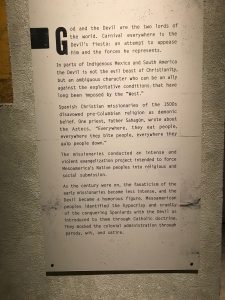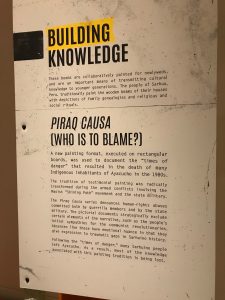In the Museum of Anthropology at the UBC Vancouver Campus, the “Arts of Resistance Politics and the Past in Latin America” was an exhibition curated by Dr. Laura Osorio Sunnucks, that was available to be viewed from May to September 2018. As the title of the exhibition suggests, the featured artwork was from Latin America, in the forms of masks, graffiti art, murals, clothing and personal drawings. The exhibition was centered around how these pieces of artwork hold and express information of the past in Latin American countries.
Being from Vancouver, I have visited the Vancouver Art Gallery several times and have developed an enjoyment for viewing art with friends, which is what I did for this experience. I think art is universal, as in it can be created and viewed around the world. Art can be used to express and communicate without a language barrier. In the exhibition hall, it was respectfully quiet; and you could see people captivated and learning information by viewing the artwork. I got to see how these pieces of artworks have the power to radiate culture, while having important ties to the history of the origin country.
Something that caught my attention, was the vibrant colours that could be found throughout “Arts of Resistance”. I was mesmerized by the use of colour as I usually prefer neutral or darker colours. The use of striking, bright colours effectively reflects the lively and energetic nature of their cultures. Being a visual learner, seeing the artwork is a helpful way for me to learn about history. For example, in the section with the paintings and Codex, it was much easier for me look at a linear progression of history rather than reading from a textbook about it. The Codex in the exhibition illustrates the 2014 disappearance of 43 children in Mexico and is even referred to as a pictorial manuscript on the Museum of Anthropology website. (https://moa.ubc.ca/exhibition/arts-of-resistance/)
Alongside each section of the exhibit, was a description about the role of the artwork. The short write-ups provided background information and explained why these pieces of art are so important. After reading the blurbs next to the pieces of artwork, it made me think back to the first ASTU class, where we discussed the theme of memory.


In ASTU, we investigate how memory is conveyed through text, but through the exhibition, I noticed how memory can be conveyed through another artistic mode like art. Upon reflecting about what we talked about in ASTU, I realised a connection between the paintings and the themes we discussed in Sarah Polley’s movie, Stories We Tell. Like Stories We Tell,the Codex is an artist’s interpretation of history. Although it may be accurate in certain aspects, it may lack details or have a bias due to a sole person’s reconstruction of the past. Through the exhibition, there were a few labels and descriptions for certain pieces of artwork, but for the few that didn’t, I was confused about what I was looking at and was wondering if it was a continuation but due the layout, perhaps I did not connect it with the proper piece. Through this confusion, I realized the importance of fully understanding each piece of information, otherwise there would be unexplainable gaps when re-telling stories of the past. By walking through“Arts of Resistance Politics and Past of Latin America”, I was realized the purpose of the exhibition, which is an opportunity for people to see the history and culture of Latin American countries through the mode of art.